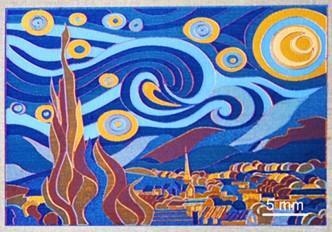Apr 20 2021
Scientists are slowly clearing the boundary between science and art by exhibiting how to use a laser to make artistic masterpieces such that they replicate classical brushes and paints.
 The researchers used their new laser painting method to make a miniature version of Van Gogh’s painting “The Starry Night.” Image Credit: Yaroslava Andreeva.
The researchers used their new laser painting method to make a miniature version of Van Gogh’s painting “The Starry Night.” Image Credit: Yaroslava Andreeva.
The new method not only makes paint-like color strokes on metal but also provides an approach to erase or alter colors.
We developed a way to use a laser to create localized color on a metallic canvas using a technique that heats the metal to the point where it evaporates. With this approach, an artist can create miniature art that conveys complex meaning not only through shape and color but also through various laser-induced microstructures on the surface.
Vadim Veiko, Research Team Leader, ITMO University
In a paper published in Optica, The Optical Society’s (OSA) journal for high impact research, Veiko and his collaborators demonstrate that their new laser tools can be utilized to make exclusive colorful paintings, comprising a miniature version of “The Starry Night,” Van Gogh’s painting.
We hope that laser painting will attract the attention of modern artists and lead to the creation of a completely new type of art. The approach can also be used for modern design and to create color markings on various products.
Yaroslava Andreeva, Research Team Member, ITMO University
Painting with Light
The latest study is based on an earlier work where the team examined how lasers can be used to create color on stainless steel and titanium. “We wanted to do more than offer a wide palette of stable colors,” stated Galina Odintsova, a member of the research team. “Thus, we worked to create a convenient tool for applying them more like an artist’s brush.”
As part of the new method, the team heated the metal to a point at which it begins to evaporate—considerably higher compared to the melting temperatures employed in methods devised earlier. Upon cooling of the metal, a very thin film of metal oxide develops. Light reflected from the top of the oxide film and the metallic surface interferes such that various colors are generated based on the film’s thickness.
Increasing the laser heating range enough to create the evaporation process makes our color strokes reversible, rewritable, erasable and much more efficient. Our marking speed is more than 10 times faster than reported before.
Galina Odintsova, Research Team Member, ITMO University
Erasable Color
A nanosecond ytterbium fiber system fitted with a galvanometric scanner was used by the researchers to make strokes that integrate surface relief with optical effects, thereby developing nine fundamental colors.
A second pass of the laser at a quicker scan rate can alter or erase the color of an area. The researchers demonstrated that the surface color of erased areas was identical to a non-treated surface and that colors can be erased and rewritten many times without any impact on the consequent color.
The researchers exhibited the new laser paintbrush by employing it to make a 3 x 2-inch version of “Starry Night” in only 4 minutes. Moreover, they created original artwork to show color mixture and erasing. The team indicates that the pictures made with the help of this laser painting method exhibit high resistance to rough environments and chemicals and do not need any kind of exclusive storage.
The team intends to combine the new laser painting potential into a portable tool that can be used much similar to a paintbrush or pen to make colorful pictures or drawings on metallic foils or metals. Moreover, the method could even help add hybrid and nanostructured materials or periodic surface gratings to realize a range of optical effects.
Journal Reference:
Veiko, V., et al. (2021) Laser paintbrush as a new tool of modern art. Optica. doi.org/10.1364/OPTICA.420074.